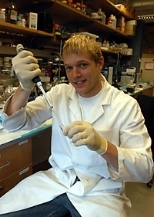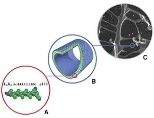An MIT senior is graduating with a scientific send-off any seasoned researcher would be proud of.
Geoffrey von Maltzahn, a chemical engineering major, is lead author of a research paper that is featured in a top scientific journal this month. In June he will present the work at an exhibition and reception for members of Congress in Washington, D.C.
Von Maltzahn was also profiled as a "whiz kid" in a recent Mass. High Tech feature recognizing the region's best and brightest engineering students, and he has won a Whitaker Foundation Graduate Fellowship and the 2003 BMES (Biomedical Engineering Society) Johnson & Johnson Excellence in Biomedical Engineering Research Prize. Recently he learned that he'll also receive MIT's Randolph G. Wei UROP Award for "the most outstanding contribution in undergraduate research at the interface of the life sciences and engineering."
Von Maltzahn's research involves creating new microscopic "carriers" to deliver molecules such as DNA to specific cells. Materials like these would help move gene therapies closer to being a part of mainstream medical science. They may also be useful in a number of other areas of biotechnology, including drug delivery. In the May 13 issue of the journal Langmuir, von Maltzahn and colleagues report the first characterization of one such material, cationic peptide surfactants.
"Geoff will achieve a great deal in the future. He almost single-handedly carried out these experiments and obtained terrific and reproducible results. This article is a tremendous achievement," said Shuguang Zhang, associate director of MIT's Center for Biomedical Engineering and a co-author of the paper. Zhang is also a principal investigator in MIT's Biotechnology Process Engineering Center. Other authors of the work are Sylvain Vauthey, a former postdoc in Zhang's lab, and Steve Santoso, a graduate student in biology.
When von Maltzahn first approached Zhang for a UROP (Undergraduate Research Oppor-tunities Program) position, his plan was to explore a different lab each semester. Two years later he is sorry to leave his first UROP.
"I sincerely hope that every student curious about the UROP program gets involved, particularly in Dr. Zhang's lab," he said. "It's afforded me a unique chance to take the initiative in my education and reach beyond my course studies. More importantly, it's been terrific fun."
The work was not always so high-profile. "When I started in the lab I was unsure of myself and there were a lot of routine tasks to learn," said von Maltzahn. "But Shuguang is so genuinely enthusiastic about the research that he made me see how exciting every little task is."
In his research, von Maltzahn attempts to produce DNA delivery systems that are efficient, non-toxic and simple to produce, and that don't trigger an immune response in the body. He is focusing on one material, cationic peptide surfactants.
There are two rules governing the behavior of this new class of molecules: their tails are averse to water, and their positively charged heads are attracted to negatively charged surfaces like DNA at low pH. When suspended in water, there is a reaction like the nanosversion of "rounding the wagons." The peptides form structures (nanotubes, nanovesicles and membranes) with their heads as the outer surface and their tails protected within.
When the attraction of the positively charged heads to a negatively charged surface like DNA is added to this process, the peptide heads surround and compact the DNA. Then a second layer forms tail to tail in an attempt to lock out the water. This way a shell is created around the DNA that could protect it from the environment in the body long enough to enter a targeted cell. Once inside the cell, the peptides would be broken down in the cell's higher-pH environment and their amino acids reused. The DNA is released.
Von Maltzahn's advice to students just starting their undergraduate career is to "constantly try to take advantage of the opportunities surrounding you." He'll do just that as he heads west to attend the University of California at San Diego's bioengineering Ph.D. program on his Whitaker Fellowship.
The research was funded by MIT's Biotechnology Process Engineering Center.
A version of this article appeared in MIT Tech Talk on May 14, 2003.







